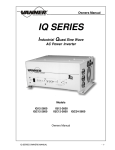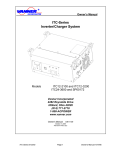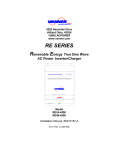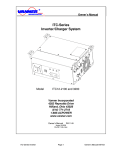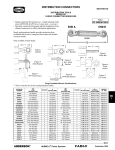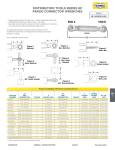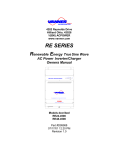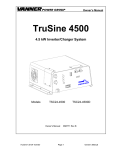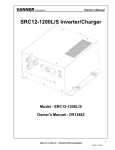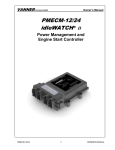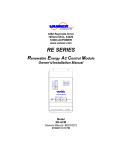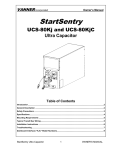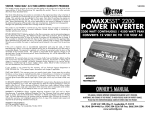Download Vanner IT24-3500 Owner`s manual
Transcript
Owners Manual IT SERIES Industrial True Sine Wave AC Power Inverter IT12-1400 IT12-1600 IT12-1800 Models IT12-2000 IT12-2600 IT12-2200S IT12-2800 IT12-2400 IT12-3000 IT12-3200 IT12-3600PL IT24-3500 Owners Manual D98494 IT SERIES Industrial True Sine Wave Inverter June 18, 2001 Owners Manual 1 IT SERIES Owner's Manual Typical Installation OEM Alternator OEM Wire OEM Wire OEM Wire OEM Battery 1/0 Wire Minimum 250 Amp Minimun 1/0 Wire Minimum Charging Fuse Charging Fuse Common OEM Ground at Starter or Engine Block 250 Amp Minimum Inverter Fuse See Figure 10 for Fuse and Wire Size Inverter Batteries Inverter Batteries Accessory Polarized Quick Connectors AC-2 12 Volt IT Series DC to AC Inverter AC-1 Circuit Breaker Panel Box Field AC Wiring 2 IT SERIES Industrial True Sine Wave Inverter Owners Manual Table of Contents TABLE OF CONTENTS 1 INTRODUCTION ..............................................................................................................................5 2 SPECIFICATIONS AND FEATURES................................................................................................6 SPECIFICATIONS ..................................................................................................................................6 STANDARD FEATURES ..........................................................................................................................8 PARTS AND ACCESSORIES ....................................................................................................................9 3 SAFETY INSTRUCTIONS ..............................................................................................................10 README.........................................................................................................................................10 GENERAL PRECAUTIONS.....................................................................................................................10 EXPLOSIVE GAS PRECAUTIONS ...........................................................................................................11 BATTERY PRECAUTIONS .....................................................................................................................11 4 COMPONENT IDENTIFICATION AND DESCRIPTION OF OPERATION .......................................12 (4) AUTO THROTTLE INDICATOR LIGHT (VOLT GUARD FEATURE) ........................................................13 (5) LOW BATTERY W ARNING INDICATOR LIGHT (LOW DC W ARNING) ..................................................13 (6) OVERLOAD INDICATOR LIGHT ......................................................................................................13 (7) OVER TEMPERATURE INDICATOR LIGHT........................................................................................13 (8) LOW BATTERY SHUT DOWN INDICATOR LIGHT (LOW DC) .............................................................13 (9) ON/OFF SWITCH (AND RESET SWITCH) ...................................................................................13 (10) INVERTER INDICATOR LIGHT ......................................................................................................14 (13) POSITIVE DC INPUT CONTACT ...................................................................................................14 (14) NEGATIVE DC INPUT CONTACT ..................................................................................................14 (16) CB-2 15 AMP AC OUTPUT CIRCUIT BREAKER ...........................................................................15 (17) CB-1 20 OR 30 AMP AC OUTPUT CIRCUIT BREAKER .................................................................15 (18) CHASSIS GROUND BONDING LUG ...............................................................................................15 (20) AC OUTPUT TERMINAL BLOCK CONTAINING OUTPUTS AC-1 AND AC-2...........................................15 (32) REMOTE CONTROL TERMINAL BLOCK..........................................................................................16 (32.1) Remote ON/OFF Switch Terminals 1, 2 and 3 ..................................................................17 (32.2) Remote Inverter Indicator Light (LED) Terminals 4 and 5 ..................................................17 (32.3) Auto Throttle Control (Volt Guard) Terminal 6 ...................................................................18 (32.5) Remote Low Battery Warning Terminal 8..........................................................................19 (33) GFCI DUPLEX RECEPTACLE .....................................................................................................19 (35) COOLING FAN (NOT SHOWN) ....................................................................................................19 5 INSTALLATION AND START-UP ..................................................................................................20 UNPACKING THE INVERTER .................................................................................................................20 INVERTER INSTALLATION CONSIDERATIONS ..........................................................................................20 DC W IRING CONSIDERATIONS ............................................................................................................20 DC W IRING INSTALLATION PROCEDURE ...............................................................................................21 REMOTE CONTROL W IRING INSTALLATION ............................................................................................23 AC OUTPUT W IRING INSTALLATION PROCEDURE ..................................................................................23 START-UP AND TEST PROCEDURE .......................................................................................................23 IT SERIES Industrial True Sine Wave Inverter Owners Manual 3 Table of Contents 6 PREVENTIVE MAINTENANCE AND TROUBLE SHOOTING PROCEDURES............................... 24 PREVENTIVE MAINTENANCE................................................................................................................ 24 TROUBLE SHOOTING PROCEDURES ..................................................................................................... 24 7 APPENDIX..................................................................................................................................... 26 W ARRANTY....................................................................................................................................... 26 GFCI TEST RECORD ......................................................................................................................... 27 List of Figures and Tables FIGURE 1 SPECIFICATIONS FOR MODELS RATED UP THROUGH 2400 WATTS. ............................................... 6 FIGURE 2 SPECIFICATIONS FOR MODELS RATED 2600 WATTS AND HIGHER .................................................. 7 FIGURE 3 INVERTER TOP VIEW ............................................................................................................ 12 FIGURE 4 INVERTER FRONT, RIGHT SIDE AND BOTTOM VIEW .................................................................. 14 FIGURE 5 INVERTER FRONT AND LEFT SIDE VIEW .................................................................................. 15 FIGURE 6 REMOTE CONTROL TERMINAL BLOCK ..................................................................................... 16 FIGURE 7 REMOTE CONTROL SWITCH W IRING VARIATIONS ..................................................................... 17 FIGURE 8 AUTO THROTTLE CONTROL DIAGRAM (VOLT GUARD FEATURE) ............................................. 18 FIGURE 9 REMOTE LOW BATTERY W ARNING ......................................................................................... 19 FIGURE 10 DC CABLE AND FUSE SIZING CHART ...................................................................................... 21 FIGURE 11 UL LISTED RING TERMINALS FOR DC CABLES ........................................................................ 22 FIGURE 12 GFCI TEST RECORD ............................................................................................................ 27 4 IT SERIES Industrial True Sine Wave Inverter Owners Manual Introduction 1 INTRODUCTION Thank you for purchasing a Vanner IT SERIES Inverter. We are confident that you will be satisfied with its performance and its many features. With proper installation and care, you can look forward to years of service from this high performance product. “IT” stands for Industrial True Sine Wave. The IT SERIES is a family of dependable inverters designed to meet the severe service requirements of the industrial market. All models of the IT SERIES produce true sine wave AC output power. This document will describe the operation, technical specifications and installation procedures of the various models and accessories offered in this product family. We suggest that you familiarize yourself with the model numbers of the inverter and optional accessories you have purchased before proceeding with this manual. If you require additional information please contact your dealer, or contact us directly at 1-800-227-6937 (800 AC POWER). WARNING: Before you install and use your IT SERIES Inverter be sure to read and save these safety instructions. Model Listing The IT SERIES product line is designed to meet the requirements of a variety of applications. In order to meet these requirements we offer 12 volt models in 200 watt increments. NOTICE: All models of the IT SERIES use the same front panel and therefore look identical. To identify the model number of your particular unit it is necessary to refer to the Specification Label located on the right side of the unit or to the Identification Label located on the front. Please note your model and serial number here for future reference. Model No.________________ Serial No.________________ Date of Installation ______________ IT SERIES Industrial True Sine Wave Inverter Owners Manual 5 Specifications and Features 2 Specifications and Features Specifications Figure 1 Specifications for models rated up through 2400 watts. Model Number SPECIFICATIONS IT12-1400 IT12-1600 IT12-1800 IT12-2000 IT12-2200S IT12-2400 Rated Output Watts * 1400W 1600W 1800W 2000W 2200W 2400W Continuous Output 11.7A 1400W 13.3A 1600W 15.0A 1800W 16.7A 2000W 18.3A 2200W 20.0 A 2400W Surge Output at 3 seconds 22.9A 23.8A 24.7A 25.6A 41.1A 41.6A AC Power Output Output Waveform Total Harmonic Distortion Output Voltage Output Frequency DC Input Voltage Range DC Input Current Inverter OFF True Sine Wave Less than 4% THD for all loads up to surge output 120 Volts ± 5% 60 Hz ± 0.025 Hz (0.04%) IT12-XXXX = 10.5 - 16.6 VDC / IT24-3500 = 21.0 TO 33.2 VDC 1 ma Inverter ON in Load Demand Mode (No AC load) Full load at 12VDC AC Output Wiring Method One Built-in Receptacle Two Hardwire Output Circuits System Ambient Operating Temperature Cooling Air Enclosure Dimensions - All Models Unit Weight IT12-XXXX =0.5 amps / IT24-3500 = .255 amps 160A 185A 210A 225A 235A 260A GFCI Duplex Receptacle protected by a 15 amp circuit breaker Output AC-1: protected by a 20 amp circuit breaker on models up through 2400 watts, 30 amp circuit breaker on models 2600 watts and higher Output AC-2 protected by the 15 amp GFCI feedthrough on all units -40 to +105ºF (-40 to +40ºC) 45 Ibs Thermostatically controlled intake fan White painted aluminum 8.0"H x 13.75"W x 15.75"D 48 lbs 57 lbs 46 Ibs 47 lbs 70 lbs *Note: The inverter will try to power any load, even a short circuit, for 3 seconds. When the load exceeds the inverter's rated output the Overload Indicator Light will turn ON. After 3 seconds, the inverter will reduce the AC Output Voltage as needed to limit the AC Output Current. If the inverter reduces output voltage below 108 volts for 10 seconds, the inverter will shut itself OFF for Overload. 6 IT SERIES Industrial True Sine Wave Inverter Owners Manual Specifications and Features Figure 2 Specifications for models rated 2600 watts and higher Model Number SPECIFICATIONS IT12-2600 IT12-2800 IT12-3000 IT12-3200 IT12-3600PL IT24-3500 Rated Output Watts * 2600W 2800W 3000W 3200W Continuous Output 21.7A 2600W 23.3A 2800W 25.0A 3000W 26.7A 3200W 3600W for 30 minutes minimum** 30.0A 3600W Surge Output at 3 seconds 42.1A 42.6A 43.2A 43.7A 43.7A AC Power Output Output Waveform Total Harmonic Distortion Output Voltage Output Frequency DC Input Voltage Range DC Input Current Inverter OFF Two Hardwire Output Circuits System Ambient Operating Temperature Cooling Air Enclosure Dimensions - All Models Unit Weight 29.2 A 3500W 83.0A True Sine Wave Less than 4% THD for all loads up to surge output 120 Volts ± 5% 60 Hz ± 0.025 Hz (0.04%) IT12-XX.XX = 10.5 - 16.6 VDC / IT24-3500 = 21.0 TO 33.2 VDC 1 ma Inverter ON in Load Demand Mode (No AC load) Full load at 12VDC AC Output Wiring Method One Built-in Receptacle 3500W IT12-XXXX =0.5 amps / IT24-3500 = .255 amps 285A 315A 340A 365A 365A 170A GFCI Duplex Receptacle protected by a 15 amp circuit breaker Output AC-1: protected by a 20 amp circuit breaker on models up through 2400 watts, 30 amp circuit breaker on models 2600 watts and higher Output AC-2 protected by the 15 amp GFCI feedthrough on all units -40 to +105ºF (-40 to +40ºC) 71 Ibs Thermostatically controlled intake fan White painted aluminum 8.0"H x 13.75"W x 15.75"D 75 lbs 75lbs 72 Ibs 73 lbs 75 lbs *Note: The inverter will try to power any load, even a short circuit, for 3 seconds. When the load exceeds the inverter's rated output the Overload Indicator Light will turn ON. After 3 seconds, the inverter will reduce the AC Output Voltage as needed to limit the AC Output Current. If the inverter reduces output voltage below 108 volts for 10 seconds, the inverter will shut itself OFF for Overload. ** At 77ºF(25ºC) the IT12-3600 can produce 3600 watts for at least 30 minutes before overheating. IT SERIES Industrial True Sine Wave Inverter Owners Manual 7 Specifications and Features Standard Features 1. True sine wave 120 volt AC output. 2. Total harmonic distortion less than 4% for all loads up to the Surge Output Rating. 3. Resilient electronic protection designed to handle output short circuits and output overloads. 4. Built-in Volt Guard Battery Voltage Monitor, providing ground control for an automatic throttle to insure maximum alternator output when needed. 5. Load Demand Feature to conserve DC power under no load conditions. 6. 15 amp GFCI Duplex Receptacle. 7. Two AC output circuits (one GFCI protected) with individual circuit breakers. 8. Terminal block for hardwiring the AC outputs. 9. Automatic shutoff for low or high battery voltage, overload or over temperature. 10. Remote control circuit capable of single wire input (12 or 24 volt input) or 2 wire (12 volt signal and return). 11. Remote indicator light (LED) circuit to operate a remote inverter ON/OFF status LED. 12. Remote Low Battery Warning Circuit, providing ground control for a remote warning device when battery voltage falls to 11.0 (22.0) Volts DC. 13. Terminal block for wiring remote control, remote Inverter ON/OFF LED, remote Low DC Warning device and Auto Throttle control circuits. 14. Indicator lights for Auto Throttle Signal, Low Battery Warning, Low Battery Shutoff, Over Temperature Shutoff, Overload and Inverter ON/OFF/Load Demand status. 15. All controls and wiring connections accessible from the front of the inverter. 16. Thermostatically controlled cooling intake fan. 17. Factory selectable Load Demand ON/OFF. (ON is standard.) 18. Factory selectable Five Minute Automatic Restart after shutdown due to fault. (OFF is standard.) Definitions Load Demand Feature and Load Demand Mode: The Load Demand Feature is an energy conserving feature which allows the inverter to enter the ‘Load Demand Mode’ whenever the inverter is ON and the AC load has been less than 10 watts for approximately 10 seconds. While in the ‘Load Demand Mode’ the inverter does not produce 120 volts AC but instead produces pulses of voltage which the inverter uses to look for a load. When a load greater than 10 watts is sensed, the inverter will turn fully ON to produce 120 Volts AC. The ‘Load Demand Mode’ is often also described as ‘stand-by mode’ or ‘sleep mode’. While in the ‘Load Demand Mode’ 12-volt models consume approximately 0.5 amps of DC and 24-volt models consume approximately 0.25 amps of DC. 8 IT SERIES Industrial True Sine Wave Inverter Owners Manual Specifications and Features Parts and Accessories Part Number Name Description 03644 04521 04523 03646 03637 Bussmann Fuse ANL-250 Bussmann Fuse ANN-300 Bussmann Fuse ANN-400 Bussmann Fuse ANL-500 Bussmann Fuse Holder 4164 250 amp DC fuse for charging cable 300 amp DC input fuse for IT12-1400 thru IT12-2000 400 amp DC input fuse for IT12-2200S 500 amp DC input fuse for IT12-2400 and larger Fuse holder for the above DC input fuses D07923-00 Quick Connect DC Input Cable 18” long 4/0 DC Input Cable with 3/8” ring terminals and polarized 350 amp Quick Connector. D07923-01 1/0 Quick Connect Cable Set For use with customer supplied 1/0 DC input cable for IT12-1400 thru IT12-2000. Includes D07923-00 and mating quick connector for 1/0 cable. D07923-02 2/0 Quick Connect Cable Set For use with customer supplied 2/0 DC input cable for IT12-1400 thru IT12-2000. Includes D07923-00 and mating quick connector for 2/0 cable. D07923-03 3/0 Quick Connect Cable Set For use with customer supplied 3/0 DC input cable for IT12-1400 thru IT12-2200S. Includes D07923-00 and mating quick connector for 3/0 cable. D07923-04 4/0 Quick Connect Cable Set For use with customer supplied 4/0 DC input cable for all IT models. Includes D07923-00 and mating quick connector for 4/0 cable. D08403 DC Input Compressing Fitting Kit Includes 2) D08241 Compression Fittings and Installation Diagram D98403. Accepts DC input cables up to 250MCM. D08506 Remote Switch Assembly SPST Toggle Switch, 25 foot long cable, 1amp fuse and fuse holder. 73-46 Automatic Throttle Vanner Automatic Throttle for mechanical throttle linkages. (The 73-46 does not apply to electronic engines having no mechanical linkage to the accelerator pedal.) 05235 12 volt 30 amp Bosch Relay Automotive 12 volt SPDT relay with 30 amp contacts. D08546 20 Amp AC Output Cord Set NEMA L5-20R receptacle (120 volt, 20 amp, twistlock) on 1’ long 12/3 SO cable with ring terminals and includes a mating NEMA L5-20P plug. D07924 30 Amp AC Output Cord NEMA L5-30R receptacle (120 volt, 30 amp, twistlock) receptacle on 1' long 10/3 SO cable with ring terminals. IT SERIES Industrial True Sine Wave Inverter Owners Manual 9 Safety Precautions 3 SAFETY INSTRUCTIONS README WARNING: Before you install and use your IT SERIES AC Power Inverter, be sure to read and save these safety instructions. This manual contains important safety and operating instructions for the Vanner Power Group IT SERIES Power Inverter as prescribed by Underwriters Laboratories (UL). The IT SERIES inverter is listed as compliant with UL 458, Power Converters/Inverters and Power Converter/Inverter Systems, and UL 1741 Power Conditioning Units for use in Residential Photo-voltaic Power Systems. The IT SERIES is also listed in the Canadian National Standard CSA – C22.2 No. 107.1957. NOTICE: The output waveform of the IT SERIES inverter is sinusoidal. Total harmonic distortion is less than four percent. CAUTION: Read owners manual BEFORE wiring or powering up. CAUTION: Not intended for DC input directly from a solar array. Batteries must be used. CAUTION: DO NOT cover or obstruct ventilation openings. DO NOT mount in a zero-clearance compartment. Overheating may result. WARNING: Under high ambient temperature / high-power-output conditions some parts of the inverter may become hot enough to cause burns. The unit should be installed so that it is not to be contacted by personnel. WARNING: This equipment employs components that tend to produce arcs and sparks. To prevent fire or explosion, DO NOT install in confined areas or compartments that contain batteries or flammable materials. WARNING: Improper use of this product may result in risk of electrical shock. Both AC and DC voltage sources are terminated inside this equipment. Use only the ground fault circuit interrupter (GFCI) receptacle(s) or circuit breaker(s) specified in the installation and operating instructions. Other types may fail to operate properly when connected to this equipment. DANGER: Battery connections are for disconnect only, NOT for current interruption. General Precautions 1. Do not expose the inverter to direct water spray or snow. 2. To reduce the risk of a fire hazard, do not cover or obstruct the ventilation openings. 3. Do not install the inverter in a zero clearance compartment. This may result in overheating or diminished performance. 4. To avoid the risk of fire, electrical shock, or injury to persons, do not use attachments not recommended or sold by the Vanner Power Group. 5. Vanner recommends that all AC and DC electrical wiring be performed by a licensed electrician or a qualified technician to ensure compliance with all applicable national and local wiring regulations. 6. To avoid a risk of fire and/or electrical shock, always verify wiring connections are in good electrical condition. All external conductors must use proper wire size to avoid dangerous overheating or diminished performance. 7. If the inverter has been dropped or damaged in any way, do not operate the inverter until it has been verified to be safe by a qualified technician. 10 IT SERIES Industrial True Sine Wave Inverter Owners Manual Safety Precautions 8. To reduce the risk of electrical shock, always disconnect the AC and DC connections to the inverter before attempting any maintenance. Simply turning the inverter off does not prevent electrical shock. 9. The inverter must be properly grounded in accordance with local and national codes and ordinances before operation. For most installations, the negative (ground) conductor should be bonded to the grounding system at one and only one point in the system. 10. For optimum inverter performance, battery temperature should be above 32 degrees Fahrenheit. 11. Do not disassemble the inverter. See the service section of this manual for instructions on obtaining service. Attempting to service the inverter yourself may result in a risk of electrical shock, fire and/or loss of warranty. Explosive Gas Precautions 1. This equipment contains components, which tend to produce arcs or sparks. To prevent fire or explosion, do not install in compartments containing batteries or flammable materials, or in locations that require ignition protected equipment. This includes any space containing gasoline-powered machinery, fuel tanks, or joints, fittings, or other connections between components of the fuel system. 2. To reduce the risk of battery explosion, follow these instructions, the battery manufacturer instructions, and the instructions of the manufacturer of the equipment in which the battery is installed. Working near a lead-acid battery is dangerous. Batteries generate explosive gases during normal battery operation. Battery Precautions 1. Always have someone within range of your voice to come to your aid when you work near a lead-acid battery. 2. Have close access to plenty of fresh water and soap in case battery acid contacts skin, clothing, or eyes. 3. Always wear complete eye protection and clothing protection. Avoid touching eyes while working near batteries. 4. If battery acid contacts skin or clothing, wash immediately with soap and water. If acid enters eye, immediately flood eye with running cold water for at least 20 minutes. Get medical attention immediately. 5. NEVER smoke or allow a spark or flame near a battery. Gases produced by batteries are explosive. 6. Be careful when working with metal tools around batteries. Potentials exist for sparks or short-circuit of the battery or other electrical part which could cause an explosion. IT SERIES Industrial True Sine Wave Inverter Owners Manual 11 Component Identification and Description of Operation 4 COMPONENT IDENTIFICATION and DESCRIPTION of OPERATION Figure 3 Inverter Top View (1) Top entry for positive DC input cable (2) Top entry for negative DC input cable (3) Top entry for Remote Control Terminal Block 12 IT SERIES Industrial True Sine Wave Inverter Owners Manual Component Identification and Description of Operation (4) Auto Throttle Indicator Light (Volt Guard Feature) (see also item (32.3) Terminal 6 Auto Throttle Control Terminal) Light Display Description Green Light is ON The Auto Throttle Signal (ground signal) is ON due to battery voltage remaining below 12.6 (25.2) volts for 15 seconds. The Indicator Light and the Auto Throttle Signal will remain ON until battery voltage remains above 13.8 (27.0) volts for 15 seconds. The indicator light will also remain ON at full load output. The Volt Guard Feature is designed to control an automatic throttle on vehicles where the inverter is required to operate continuous, heavy AC loads. By controlling the auto throttle the Volt Guard Feature will insure that the vehicle’s alternator operates at maximum output when needed. The Volt Guard circuit is designed to provide ‘ground control’ for a Bosch relay, Vanner part number 05235 or equal. Use the Bosch relay to operate the automatic throttle, Vanner 73-46 Automatic Throttle or equal. See Figure 5 for details and Figure 7 for a schematic diagram. (5) Low Battery Warning Indicator Light (Low DC Warning) Light Display Description Yellow Light is ON The inverter is ON and battery voltage has decreased to less than 11 (22) volts DC. Automatic inverter shutdown for low battery at 10.5 (21) volts is imminent unless the battery voltage is increased. (6) Overload Indicator Light Light Display Description Solid Red The inverter is ON but the inverter’s AC output circuitry is sensing an overload condition. If the AC load is not reduced, the inverter will shut itself OFF after approximately 12 seconds. Blinking Red The inverter has shut itself OFF due to overload. The Inverter ON/OFF Switch must be cycled to reset and restart the inverter. (7) Over Temperature Indicator Light Light Display Description Blinking Red The inverter has shut itself OFF due to over temperature. The Inverter ON/OFF Switch must be cycled to reset and restart the inverter. (8) Low Battery Shut Down Indicator Light (Low DC) Light Display Description Blinking Red Battery voltage has fallen below 10.5 volts (21 volts) and the inverter has shut itself OFF. The Inverter ON/OFF Switch must be cycled to reset and restart the inverter. (9) ON/OFF Switch (and RESET Switch) The ON/OFF Switch is a two-position rocker switch used to turn the inverter ON/OFF and is used as a RESET Switch. When the inverter has automatically shut itself OFF due to a fault, the inverter must be RESET by turning the ON/OFF Switch OFF or by turning a remote switch OFF. (If an automatic shutdown has occurred due to a fault, one of the fault indicator lights will be displayed until the inverter is RESET. IT SERIES Industrial True Sine Wave Inverter Owners Manual 13 Component Identification and Description of Operation (10) Inverter Indicator Light Light Display Description Green Light is OFF Inverter is OFF Solid Green Inverter is ON and is producing AC power Blinking Green Inverter is in Load Demand Mode Figure 4 Inverter Front, Right Side and Bottom View (11) Bottom entry for positive DC input cable (12) Bottom entry for negative DC input cable (13) Positive DC Input Contact (14) Negative DC Input Contact (15) Bottom entry for Remote Control Terminal Block 14 IT SERIES Industrial True Sine Wave Inverter Owners Manual Component Identification and Description of Operation (16) CB-2 15 Amp AC Output Circuit Breaker CIRCUIT BREAKER CB-2 (bottom breaker) protects the GFCI Receptacle and AC Output AC-2. (17) CB-1 20 or 30 Amp AC Output Circuit Breaker CIRCUIT BREAKER CB-1 (top breaker) protects AC Output AC-1. CB-1 is a 20 amp breaker on models up through 2400 watts. CB-1 is a 30 amp breaker on models rated 2600 watts and higher. (18) Chassis Ground Bonding Lug (19) Bottom entry for AC output cable (20) AC Output Terminal Block containing outputs AC-1 and AC-2 (21) Side entry for AC output cable (22) N/A (23) N/A (24) Factory set-up jack (25) Air Exhaust Vents Figure 5 Inverter Front and Left Side View IT SERIES Industrial True Sine Wave Inverter Owners Manual 15 Component Identification and Description of Operation (26) Mounting Brackets ( 2 ) (27) Air Exhaust Vents (28) Side entry for negative DC input cable (29) Side entry for positive DC input cable (30) Positive DC Input Contact (31) Negative DC Input Contact (32) Remote Control Terminal Block A 9-position terminal block is provided for connecting optional, customer supplied remote control and remote display wiring. Please note that any wiring to this terminal block is optional. Figure 6 Remote Control Terminal Block 9-POSITION TERMINAL BLOCK _____________________________________________ Terminals 1,2 and 3 Remote Switch terminals. See item (32.1) and Figure 7. _____________________________________________ Terminals 4 and 5 Remote ‘Inverter ON' LED. See item (32.2). ____________________________________________ (Volt Guard Feature) Provides Terminal 6 ground control based on battery voltage. See item (32.3) & Fig 8. _____________________________________________ Provides ground control for a Terminal 8 remote Low Battery Warning Device. See item (32.5) & Fig 9. _____________________________________________ Terminal 7 and 9 16 IT SERIES REMOTE ON/OFF 1 2 SWITCHES 3 INTERNAL FUNCTION POWER-ON LED 4 +5V 5 GND 6 AUTO THROTTLE 7 8 LOW DC WARNING 9 Terminals 7 and 9 are NOT USED. Industrial True Sine Wave Inverter No connection Owners Manual No connection Component Identification and Description of Operation (32.1) Remote ON/OFF Switch Terminals 1, 2 and 3 The IT SERIES Inverter allows four styles of remote control wiring for customers who wish to supply and install a remote control switch or switches. Figure 7 Remote Control Switch Wiring Variations 9 POS BLOCK Standard Style One No Remote Switch. (Factory jumper connecting terminals 1 and 2.) Series Remote Switch powered by Terminal 2. (Factory jumper removed) JUMPER Series Remote Switch powered externally. (Factory jumper removed.) INVERTER ON/OFF 2 +12/24VDC 3 SPST REMOTE 9 POS BLOCK INVERTER INTERNAL WIRING 1 INVERTER ON/OFF 2 1A FUSE Style Two INTERNAL WIRING 1 +12/24VDC 3 SPST REMOTE 9 POS BLOCK INVERTER INTERNAL WIRING 1 INVERTER ON/OFF 2 +12/24VDC +12/24VDC 3 9 POS BLOCK INVERTER INTERNAL WIRING 1 Style Three Parallel Remote Switch powered by Terminal 2. (Factory jumper connecting terminals 1 and 2.) 1A FUSE JUMPER INVERTER ON/OFF 2 +12/24VDC 3 INVERTER SPST REMOTE 9 POS BLOCK INTERNAL WIRING 1 Style Four Parallel Remote Switch powered externally. (Factory jumper connecting terminals 1 and 2.) JUMPER +12/24VDC INVERTER ON/OFF 2 +12/24VDC 3 INVERTER SPST REMOTE (32.2) Remote Inverter Indicator Light (LED) Terminals 4 and 5 (See also item (10) Inverter Indicator Light Use Terminals 4 and 5 to operate a customer supplied remote Inverter LED through a 470-ohm resistor. The LED will light when the inverter is ON or in Load Demand Mode. A remote Inverter LED does not blink when the inverter is in Load Demand Mode. IT SERIES Industrial True Sine Wave Inverter Owners Manual 17 Component Identification and Description of Operation (32.3) Auto Throttle Control (Volt Guard) Terminal 6 (See also item (4) Auto Throttle Indicator Light) The Auto Throttle Control (Volt Guard Feature) provides a ‘ground signal’ at Terminal 6 and turns ON the Auto Throttle Indicator Light whenever battery voltage remains below 12.6 (25.2) volts for more than 15 seconds. The ‘ground signal’ and the indicator light both turn OFF after battery voltage remains above 13.8 (27.0) volts for 15 seconds. The circuit is designed to provide ‘ground control’ for a Bosch relay, Vanner part number 05235 or equal. Use the Volt Guard Feature to control an automatic throttle on vehicles where the inverter is required to operate continuous heavy AC loads or where other heavy DC loads are present. By controlling the auto throttle in reference to battery voltage, the Volt Guard Feature insures that the vehicle alternator produces maximum output when needed. Use the Bosch relay to control the automatic throttle, Vanner 73-46 Automatic Throttle or equal. Install a ½ amp in-line fuse near the inverter as shown. The sketch below follows the 73-46 Automatic Throttle wiring instructions as for a Dynamic Inverter installation. This requires separating the input signal circuit from the input power circuit by cutting the Red 18GA jumper on the Auto Throttle Control Module. The Bosch relay may also control the Auto Throttle via the ground similar to the Volt Guard circuit shown in the 73-46 Auto Throttle instructions. For ground control, route the Auto Throttle’s white/black wire through the Bosch relay’s N.O. contacts. Figure 8 Auto Throttle Control Diagram (Volt Guard Feature) 9 POS BLOCK VANNER 73-46 AUTO-THROTTLE CONTROL MODULE INTERNAL WIRING RED 18 12VDC HOT IN RUN VOLT GUARD CIRCUITRY 6 BOSCH RELAY 05235 1/2 AMP FUSE 1 AMP FUSE (32.4) Terminal 7 Not used. 18 IT SERIES Industrial True Sine Wave Inverter Owners Manual Component Identification and Description of Operation (32.5) Remote Low Battery Warning Terminal 8 (See also item (5) Low Battery Warning Indicator Light (Low DC Warning) Terminal 8 is designed to provide ground control for a Bosch relay, Vanner part number 05235 or equal, to operate in conjunction with the Low DC Warning Indicator Light. Use the Bosch relay to operate an audible alarm, lights or other warning device. The warning will alert personnel that battery voltage has fallen to 11 (22) volts and automatic inverter shut down for low battery voltage at 10.5 (21) volts is imminent. Install a ½ amp in-line fuse near the inverter as shown. Figure 9 Remote Low Battery Warning 9 POS BLOCK ALARM INTERNAL WIRING LOW DC SHUTDOWN CIRCUITRY 12VDC HOT IN RUN 8 BOSCH RELAY 05235 1 AMP FUSE 1/2 AMP FUSE (32.6) Terminal 9 Not used. (33) GFCI Duplex Receptacle The GFCI is protected by 15 amp Circuit Breaker CB-2 and protects terminal block Output AC-2. (34) AC Output Wiring Compartment (35) Cooling Fan (Not shown) The cooling air intake fan is located on the back of the inverter. Air is drawn in at the back of the inverter and is exhausted on both sides. Allow a minimum of 1½” clearance (40 mm) at the back of the inverter and on both sides to insure proper cooling. IT SERIES Industrial True Sine Wave Inverter Owners Manual 19 Installation and Start-up 5 INSTALLATION and START-UP Unpacking the Inverter 1. Inspect the shipping container and equipment for loose or damaged parts. If any damage is found, immediately notify the freight carrier. Inverter Installation Considerations 1. Mounting: Locate a secure, dry, flat horizontal or vertical surface large enough to mount the inverter. The location should be as close to the battery as possible, usually within six feet, but not in the same compartment and should provide adequate ventilation while the inverter is operating. The location must be clean, dry and free from road spray, dripping water or other moisture contamination. 2. Cooling Fan Clearance: The mounting location must allow unobstructed airflow for cooling. Allow a minimum clearance of 1½ inches (40 mm) on the left, right and back sides of the inverter. The Cooling Fan is a thermostatically controlled intake fan. Air is drawn into the inverter from the backside and exhausted through vents on the left and right sides. Obstruction of the fan intake or the exhaust vents will diminish the inverter output capacity due to overheating. DC Wiring Considerations 1. A DC FUSE IS REQUIRED to properly protect the inverter in case the battery cables are connected backward (reverse polarity). 2. The wiring of your inverter installation should conform to the National Electric Code (NEC) and any other state or local codes in effect at the time of installation. These codes have been written for your protection and their requirements should be followed. Article 551 of the NEC requires any DC cable from a battery, which measures longer than 18 inches along its length, be protected by a fuse. 3. BE AWARE, as a large number of capacitors become charged upon completion of the DC circuit, THERE WILL BE A LARGE SPARK when the last battery connection is made. The spark is normal and will occur every time the batteries are connected. It is advisable to make the last DC connection at the input fuse, not at the battery, to reduce the risk of battery explosion. 4. Route the AC output wiring and DC power wiring with as much physical separation as possible from low voltage wiring such as audio and video signal wires. 5. Route the DC positive and negative cables as close together as possible and use cable ties to keep them together. This reduces electromagnetic radiation that could interfere with sensitive electronics. 6. If passing through steel or other ferrous metal walls, the DC input cables need to pass through the same hole to prevent causing a transformer effect. If two holes are required, cut a slot to connect the two holes to prevent heating of the ferrous metal. 20 IT SERIES Industrial True Sine Wave Inverter Owners Manual Installation and Start-up 7. Proper DC cable size is critical for the performance and safe operation of the inverter system. The DC Cable and Fuse Sizing Chart shows the minimum recommended cable sizes. These sizes allow a ½ volt maximum voltage drop at maximum inverter capacity and will insure optimum inverter performance. Quick DC cable connectors are available. See Parts and Accessories. 8. Do not use the vehicle chassis as the DC negative conductor. The negative cable should be the same size as the DC positive cable and should be connected directly to the battery negative terminal. 9. DC cables should be as short as possible. Fuse (Bussmann) Vanner part number IT24-3500 IT12-3200 IT12-3000 IT12-2800 IT12-2600 IT12-2400 IT12-2200S IT12-2000 IT12-3600PL Cable Size 1/0 2/0 3/0 4/0 250MCM IT12-1800 Model Number IT12-1600 DC Cable and Fuse Sizing Chart IT12-1400 Figure 10 NR NR NR 10* 12* NR NR NR 11 13 Distance from battery to inverter in feet (Length of cable needed is 2 times the distance.) 12 16 20 20 20 11 13 16 20 20 10 12 15 19 20 ANN300 04521 Fuse Holder 9 11 14 18 20 NR NR 14 17 20 NR NR NR 15 17 ANN400 04523 NR NR NR 14 16 NR NR NR 13 16 NR NR NR 12 14 NR NR NR 11* 13* ANL500 03646 Vanner part number 03637 (Bussmann 4164) *For 12 volt models rated-2800 watts and higher use cable rated 90°C, UL listed 4/0 cable 03558, or equal. Note: A 500 amp fuse is required to achieve full surge output capacity on Model IT24-3500. Usage of the 500 amp fuse dictates using 4/0 cable or larger. DC Wiring Installation Procedure 1. The DC wiring enclosure is located on the left front of the inverter. The DC cables may enter the inverter through top, bottom or left side openings (see figures 1,2,and 3). Two cable clamps and four plastic hole plugs are provided. Bolts are provided for connecting 5/16 diameter ring terminals to the DC Input Contacts. Optional compression lugs (Vanner part no. D08241) are available for cables sizes up to 250 MCM. 2. Select a location for the inverter. An ideal location is close to the battery; protected from weather and moisture; and well ventilated. 3. Select an accessible location for the DC Fuse. The location should be within 18” of the battery and accessible for visual inspection and replacement. If possible locate so the last DC connection can safely be made at the fuse. IT SERIES Industrial True Sine Wave Inverter Owners Manual 21 Installation and Start-up 4. Remove the cover plate on the DC cable compartment to expose the positive and negative DC contacts and the Remote Control Terminal Block. 5. Prepare DC cable ends. Use ring terminals or, if using the optional D08241 Compression Lugs, leave the cable ends bare. Figure 11 UL Listed Ring Terminals for DC Cables Wire Gauge Molex Part No. Ring Size Molex Description 1/0 H-381-56 H-791-56 H-981-56 5/16 2/0 J-385-56 J-785-56 J-985-56 3/0 K-390-56 N/A K-990-56 Recommended Crimp Tools Molex Brand AC Terminals Inc Brand Versacrimp* Nylacrimp Funnel Nylacrimp DLHH, PPDLH, SKT-840 DLHH, PPDLH DLHH, PPDLH Crimp Master 0280 5/16 Versacrimp* Nylacrimp Funnel Nylacrimp DLHH, PPDLH, SKT-840 DLHH, PPDLH DLHH, PPDLH Crimp Master 0280 5/16 Versacrimp* Nylacrimp Funnel Nylacrimp DLHH, PPDLH, SKT-840 DLHH, PPDLH DLHH, PPDLH Crimp Master 0280 L-395-38 Versacrimp* DLHH, PPDLH, SKT-840 Crimp Master 4/0 N/A 3/8 Nylacrimp DLHH, PPDLH 0280 L-995-38 Funnel Nylacrimp DLHH, PPDLH *Require shrink wrap insulation applied to barrel: 1/0 to 2/0 use Molex PFV-¾, 3/0 to 4/0 use PFV-1. Molex telephone number 813-521-2700. AC Terminal telephone number 614-868-9828. 6. Verify that the battery positive cable is not connected to the battery. Insert DC cables through the strain reliefs and into the DC wiring compartment. Torque DC cable mounting bolts to 180 inch pounds. Re-torque after 30 days. (If using the optional D08421 Compression Lugs, torque the Allen mounting screw to 180 inch pounds and the Allen compression screw to 240 inch pounds. Re-torque after 30 days.) Tighten the two strain relief cable clamps. Insert the four plastic plugs into the unused cable openings. 7. Inspect the DC cable compartment to be sure no copper wire fragments are present after tightening cables. 8. Route the negative DC cable to the battery. Verify cable polarity before proceeding. The fuse will be blown and inverter can be damaged if the DC cables are reversed. Route the positive DC input cable to the fuse and then to the battery. Protect cables with loom and use grommets or other appropriate means where cables may contact hard, sharp edges. If possible, make the last DC connection at the fuse to avoid causing a spark at the battery. 9. Connect Chassis Ground Bonding Lug to the vehicle chassis and/or earth ground using AWG No.8 or larger copper conductor. 10. Verify that the inverter will turn ON but do not leave the inverter connected to the battery at this time (remove the fuse). Final battery connections will be made after all control and AC output installation issues have been inspected. 22 IT SERIES Industrial True Sine Wave Inverter Owners Manual Installation and Start-up Remote Control Wiring Installation 1. Refer to the wiring sketches found in the Component Identification and Description of Operation section, item (32), Remote Control Terminal Block. Use fuses where indicated. 2. Use cable clamp provided to secure wiring. A plastic plug is provided for the unused opening. AC Output Wiring Installation Procedure WARNING: Before proceeding with the AC wiring, verify that the inverter is OFF and that the inverter is NOT connected to the battery. Serious or fatal electrical shock may occur. 1. The wiring of your inverter installation should conform to the National Electric Code (NEC) and any other state or local codes in effect at the time of installation. These codes have been written for your protection and their requirements should be followed 2. Route the AC output wiring, and DC power wiring, with as much physical separation as possible from low voltage wiring such as audio and video signal wires. 3. Remove the right front cover to expose the AC wiring compartment and the AC Output Wiring Terminal Block. Output Circuits AC-1 and AC-2 are identified on the terminal block label and are defined in Section 2, items 16, 17 and 20. 4. A cable clamp is provided to secure the AC output wiring. A plastic plug is provided to plug the unused opening. 5. Verify AC wiring installation. Verify that all connections are tight. Secure all wiring. Start-up and Test Procedure After the inverter has been properly mounted with sufficient ventilation, DC cables have been connected to the inverter (but not yet to the battery), AC wiring has been completed, and all remote connections have been checked; the Start-up and Testing procedure should be performed. WARNING: These procedures are to be performed only by a QUALIFIED INSTALLER. Inverter Start-up and Testing 1. Place the Inverter ON/OFF switch in the OFF position. 2. Place any remote switches in the OFF position. 3. Verify that any external AC output circuit breakers and GFCI receptacles are reset. 4. Connect the battery to the inverter. BE AWARE, as a quantity of capacitors become charged upon completing the DC circuit, THERE WILL BE A LARGE SPARK when the last connection is made. 5. Turn the inverter ON and use a test load (75 watt trouble light) plugged into the 15 amp GFCI receptacle to verify the inverter produces AC power. 6. Refer to the description of operation of the indicator lights, Section 2, items 4 through10 to follow and verify correct inverter operation. 7. If the inverter is not operating as described, see Trouble Shooting Procedures IT SERIES Industrial True Sine Wave Inverter Owners Manual 23 Preventive Maintenance and Trouble Shooting Procedure 6 Preventive Maintenance and Trouble Shooting Procedures There are no user serviceable components inside the inverter. If the inverter requires service, refer to the Vanner Power Group or other qualified service personnel. Preventive Maintenance For continued reliability and safety, a monthly maintenance program should be implemented to include the following: 1. Check to insure that all wiring connections are tight, secure and corrosion free. 2. Check fan intake and exhaust vents for obstructions. 3. Examine receptacle, indicators and switches for cracks and breaks. 4. Examine any surfaces that are discolored or deformed due to excessive heat. Trouble Shooting Procedures The following are the most common questions heard by Vanner service professionals. If your situation does not apply to the following categories, please contact your local Vanner Power Group Service Center or the Vanner Power Group Customer Service Department: 1-800-AC-POWER (1-800-227-6937). Please have your model and serial number available when consulting customer service. Preliminary Checks 1. Indicator Light status 2. Inverter ON/OFF Switch and Remote ON/OFF Switch positions 3. AC Output Breakers CB-1, CB-2 4. Check all GFCI receptacles and circuit breakers as equipped throughout AC system 5. Battery voltage at battery and battery voltage at the inverter. Voltage present at inverter does not prove that all connections are sound especially under no AC load. (see item 7) 6. DC Fuse condition 7. Battery connections for tightness or corrosion 8. Try operating an AC load from the GFCI receptacle located on inverter front panel Problem Symptoms and Troubleshooting Checks Problem: Check: Inverter Indicator Light does not turn ON. Verify DC voltage at the inverter. Problem: Check: Inverter Indicator Light is ON but the AC load will not operate. Check and reset GFCI receptacle or circuit breakers. Verify AC wiring. Try a different load such as a trouble light. Problem: Check: Low Battery Indicator Light is ON when AC load is applied. Check battery connections and condition. Recharge battery if voltage is less than 10.5 (21.0) VDC. Problem: Check: Over Temperature Indicator Light is ON. Verify fan operation. Remove obstructions from air exhaust vents and cooling fan. 24 IT SERIES Industrial True Sine Wave Inverter Owners Manual Preventive Maintenance and Trouble Shooting Procedure Problem: Check: Overload Indicator Light is ON when AC load is applied. Verify AC load is within the inverter’s rated capacity. Remove excessive loads. Problem: Check: DC fuse blows when connecting DC input cables. Check for reverse polarity (Positive and negative DC cables reversed.) Problem: Check: Excessive audible buzzing during inverter operation but inverter operates loads. Check mounting bracket bolt tightness. Problem: Check: AC loads do not seem to be fully energized when operating from inverter power. Check AC output voltage at convenience receptacle. Check for overheated DC or AC wiring. Verify AC load specifications are not exceeded. Problem: Check: Unit does not operate and a “burnt wire” smell emits from inverter. Disconnect AC loads and battery immediately. Unit may require service, contact Vanner service department. IT SERIES Industrial True Sine Wave Inverter Owners Manual 25 Appendix 7 APPENDIX Warranty NORTH AMERICAN LIMITED WARRANTY Vanner Inc., doing business as The Vanner Power Group, referred to herein as Vanner, warrants that this product is free from defects in materials and workmanship for a period of two (2) years from date of installation or two and one half (2 1/2) years from date of manufacture, whichever is less if and only if the following requirements are complied with: 1. The product is installed and checked out properly according to all guidelines, instructions, and checkout procedures set forth in the product Installation and Operating Manual. 2. The installer records all checkout data required and completes, signs, and returns the warranty registration card to Vanner within ten (10) days after installation. 3. The product was purchased after January 1, 2000. Vanner does not warrant its products against any and all defects when: defect is a result of material or workmanship not provided by Vanner; normal wear and tear, or defects caused by misuse or use in contrary to instructions supplied, neglect, accident, reversed polarity, unauthorized repairs and/or replacements. All warranties of merchantability and fitness for a particular purpose: written or oral, expressed or implied, shall extend only for a period of two (2) years from date of installation or two and one half (2 1/2) years from date of manufacture, whichever is first. There are no other warranties that extend beyond those described on the face of this warranty. Some states do not allow limitation on how long an implied warranty lasts, so the above limitations may not apply to you. Vanner does not undertake responsibility to any purchaser of its product for any undertaking, representation, or warranty made by any dealers or distributors selling its products beyond those herein expressed unless expressed in writing by an officer of Vanner. Vanner does not assume responsibility for incidental or consequential damages, including, but not limited to, responsibility for loss of use of this product, removal or replacement labor, loss of time, inconvenience, expense for telephone calls, shipping expense, loss or damage to property, or loss of revenue. Some states do not allow the exclusion or limitation of incidental or consequential damages, so these limitations may not apply to you. Vanner reserves the right to repair, replace, or allow credit for any material returned under this warranty. Any damage caused by the customer will be charged or deducted from the allowance. All warranty work will be performed at Vanner’s factory, or authorized repair facility utilizing a valid Warranty Authorization Number (WAN) prior to repair. Products shall be delivered to Vanner’s facility, freight prepaid and fully insured. Products repaired under warranty, or replacement parts or products will be returned to North American location prepaid via same transportation means and level of service as received, unless directed otherwise. Prepaid freight policy does not apply to locations outside North America. 26 IT SERIES Industrial True Sine Wave Inverter Owners Manual Appendix GFCI Test Record For maximum protection against electrical shock hazard, operate the Test Switch on the Ground Fault Circuit Interrupter at least once a month and record the values in this supplied table. Figure 12 YEAR GFCI Test Record JAN FEB MAR APR MAY JUN JUL AUG SEP OCT NOV DEC 20___ IT SERIES Industrial True Sine Wave Inverter Owners Manual 27 IT Series Owner's Manual Vanner Power Group 4282 Reynolds Drive Hilliard, Ohio 43026 1-800-AC POWER (1-800-227-6937) Tel: 614-771-2718 Fax: 614-771-4904 www.vanner.com e-mail: [email protected] Manual Part Number D98494 Printed in USA 28 IT SERIES Industrial True Sine Wave Inverter Owners Manual




























